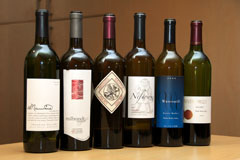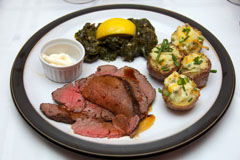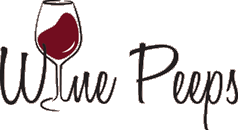Wine Tasting Dinner: Washington Malbec
By Kori ~ March 23rd, 2011.
 Malbec was originally one of the six varieties used in red Bordeaux blends along with Cabernet Sauvignon, Merlot, Cabernet Franc, Petit Verdot, and occasionally Carmenère. Today, it is only used sparingly in Bordeaux but has really come into its own as a stand-alone varietal in Argentina. In my opinion, Washington State is producing some excellent Malbec as well. In general, Malbec is not as tannic as Cabernet Sauvignon but is spicier than Merlot and goes well with a number of different foods. In 2009, Seattle Magazine selected Malbec as the Best Emerging Varietal in their Best of Washington Wine Awards.
Malbec was originally one of the six varieties used in red Bordeaux blends along with Cabernet Sauvignon, Merlot, Cabernet Franc, Petit Verdot, and occasionally Carmenère. Today, it is only used sparingly in Bordeaux but has really come into its own as a stand-alone varietal in Argentina. In my opinion, Washington State is producing some excellent Malbec as well. In general, Malbec is not as tannic as Cabernet Sauvignon but is spicier than Merlot and goes well with a number of different foods. In 2009, Seattle Magazine selected Malbec as the Best Emerging Varietal in their Best of Washington Wine Awards.
“Originally a blending grape in the Bordeaux region of France and then a varietal in Argentina, this grape is cropping up in Washington because of its ability to grow well in the hot days and cool nights of eastern Washington.†–Seattle Magazine
Last Friday, we featured Washington Malbec in our monthly wine tasting dinner. All six wines paired perfectly with Mom’s dinner of roasted pepper tomato soup, sautéed pear salad with blue cheese dressing, roasted beef tenderloin, twice-baked red potato bites, braised kale, and German chocolate dessert with whipped cream garnished with shaved chocolate.
 While all six wines were good, the 2007 à Maurice Cellars Malbec stood out from the rest. It was my favorite from the first sip right on through the meal. The 2007 Milbrandt The Estates Malbec also showed extremely well. On top of being excellent wines, the à Maurice and Milbrandt also deliver serious bang for your buck.
While all six wines were good, the 2007 à Maurice Cellars Malbec stood out from the rest. It was my favorite from the first sip right on through the meal. The 2007 Milbrandt The Estates Malbec also showed extremely well. On top of being excellent wines, the à Maurice and Milbrandt also deliver serious bang for your buck.
Anna Schafer of à Maurice Cellars is a very talented winemaker. In addition to founding à Maurice Cellars with her family in 2004, Anna has also spent time in Argentina working harvest. Given the experience she gained there, it is no wonder that she has a deft touch when it comes to producing top quality Malbec. Consistent from vintage to vintage, Anna’s à Maurice Cellars Malbec is one of the best Malbecs produced in the United States.
If you haven’t yet had the pleasure of enjoying Washington Malbec, this list is a good place to start. Enjoy!
From 1st to last in the group consensus rankings:
2007 Ã Maurice Cellars Malbec (Columbia Valley, Washington): Deep, dark red in color. Gorgeous nose with aromas of earth, game, smoked meat, and spice. Smoked meat, black cherry, and a hint of earth and spice come through on the palate. Medium to full-bodied with lively acidity and medium to high tannins. Well-balanced with good complexity and a long, smooth finish.
Quality: 4.5 stars (out of 5)
QPR: 5 bangs for your buck (out of 5)
Where to buy: Full Pull Wines (Seattle, Washington), $31; Available elsewhere, $35
2007 Milbrandt The Estates Malbec (Wahluke Slope, Washington): Deep ruby red. Aromatic with cinnamon, red fruits, and floral notes on the nose. More red fruits and floral notes as well as chocolate and licorice come through on the palate. Medium to full-bodied with lively acidity and medium to high tannins. Well-balanced with a long finish.
Quality: 4 stars (out of 5)
QPR: 5 bangs for your buck (out of 5)
Where to buy: Full Pull Wines (Seattle, Washington), $18; Available elsewhere, $18 to $27
2007 Barnard Griffin Malbec (Columbia Valley, Washington): Deep, purplish red in color. Nice nose with herbal and earthy aromas that lead to red fruit and herbal flavors. Medium-bodied with medium tannins and a long, smooth finish.
Quality: 4 stars (out of 5)
QPR: 4 bangs for your buck (out of 5)
Where to buy: Esquin Wine Merchants (Seattle, Washington), $24; Available elsewhere, $27
2008 Nefarious Cellars Malbec (Upland Vineyard, Snipes Mountain, Washington): Deep, dark purplish red. Nice nose with black cherry and spice aromas. More black cherry and cinnamon come through on the palate. Medium to full-bodied with lively acidity, medium to high, drying tannins and a long finish.
Quality: 3.5 stars (out of 5)
QPR: 2 bangs for your buck (out of 5)
Where to buy: Wine World (Seattle, Washington), $26; Available elsewhere, $28
2008 Watermill Winery Estate Malbec (Walla Walla Valley, Oregon): Deep, dark purplish red in color. Cotton candy, cinnamon, and floral aromas come through on the nose; red fruits, cinnamon, bacon, earth, and floral notes on the palate. Medium to full-bodied with lively acidity, medium to high tannins, and a long finish.
Quality: 3.5 stars (out of 5)
QPR: 2 bangs for your buck (out of 5)
Where to buy: Winery, $28; Available elsewhere, $28
2007 Seven Hills Winery Malbec (Walla Walla Valley, Washington): Deep, purplish red. Aromatic with red fruit and floral aromas. Candied red and black fruits and spice come through on the palate. Medium to full-bodied with lively acidity, medium tannins, and a medium to long, jammy finish.
Quality: 3 stars (out of 5)
QPR: 1 bang for your buck (out of 5)
Where to buy: Wine World (Seattle, Washington), $27; Available elsewhere, $23
Filed under: American Wine, Five-Bangs For Your Buck Wines, Malbec, Red Wine, Washington State Wine, Wine Tasting Dinners, Wines Over $25, Wines Under $20, Wines Under $25

 Wine Peeps is an independent wine blog dedicated to helping you get the most bang for your buck in wine. We do this through blind tastings of wine from around the world and calculations of
Wine Peeps is an independent wine blog dedicated to helping you get the most bang for your buck in wine. We do this through blind tastings of wine from around the world and calculations of 











First of all, your premise is false. yes it is used in small amount in bordeaux, but it is used in the loire valley under the names Cot and or Auxerrois. More importantly it is the main grape of Cahors, one of the 13 or so appelation of the south-west region of France and many producers have been making great wines there for a long time. Yes Argentina also has great examples of wines made from this variety and the consumer who only know wines by their grape name do not know wines, therefore associate malbec with Argentina as you have yourself expressed. wine is more than just fermented grape juice, hence wines from Europe are named after a town, a vineyard, or region ( the notion of terroir ). After all, we talk of idaho potatos, vidalia onions and meyer lemon. As for cheese, we talk about Gorgonzola, Crotin de Chavignol, brie, Gouda and not about cow, goat, ewe, or sheep.
Nice review.
Dinner sounded great and I’m sure the wines were as good as you say.
itsoffal,
Thanks for sharing your knowledge of Malbec. While I am well aware of the many places in Europe where Malbec is grown and, therefore, sold under its place name, my intention with this post was not to present a comprehensive history of the grape. Rather I was trying to give a brief introduction for those who may not be familiar with it before writing about the Washington Malbecs we tasted in this dinner. Since Malbec is varietally labeled in Argentina and heavily exported, many wine consumers in the United States are familiar with it from that region. This was a great dinner, and I encourage you to try some of these Washington Malbecs if you have not had them.
Eric,
Thanks. Glad you enjoyed the post.
Cheers!
10-4 Eric.
Having worked 3 different levels of the wine and food indusrty, I know too well the wrong assumptions that not just the consumer, but people who work retail and distribution, make about malbec and false information is passed around as the gospel.
when a wine mgr of a wine shop tells you that malbec is like merlot, or a customer in a restaurant wanting a P.Noir and when offered a Savigny-les-beaune or Gevrey Chambertin tells you he is looking for “real” Pinot Noir, it can certainly drive you slightly mad.
By the way I do love Washington st. wines and I am sure the Malbecs you mentionned are quite wonderful.
thanks for your response.
Wow….
Seems like you have hit the nerve of professional in the wine industry.
I thought the post was great (as all of yours are)! Concise and provides a good amount of info to the average person interested in Washington State wines.
While I am sure with your CSW background you could recite all kinds of facts about Malbec and its different uses and regions….it would bore the average person interested in a fun to read blog!
Wine does not have to be stuffy and while I may call most of my wines by varietal name……I do know my wines! I’m guessing that “itsoffal” is probably not a “Vayniac” or something along those lines!
@Brian white
You are right, I am not a “Vayniac”, although he does provide some solid and interesting information by tasting wines that most people have probably and most likely never heard of, I have to draw the line when it comes to his sippy sip and his – let’s give it a swirl, frankly too close to Rachel Ray’s – e.v.o.o. and I would never put all my eggs in one basket.
1- no nerves were damaged
2-yes Eric’s post provided some good info.
3-giving partial info is just as good as mis or dis information and full info can be concise and to the point.
4-I don’t doubt that you know your wines which then makes you part a small elite, it is not the case for most people who continously receive false info as mentionned above. to cite more examples , how many people still think that Chablis is a crappy wine made by Gallo and comes in a 5 ltr bag in the box, or a women’s mag where a Cal. winery states that women should stick to drinking american wines cause the labels are written in english, or still a Am. football coach telling a bunch of friends over dinner that all they need to know about wines is Carneros and Russian river, obvously the rest including Wahington state need not apply.
Sincerely, alain Roche.
P.S.
isn’t it amazing that due to naming wines by varietals, the consumer rarely blames the producer of a bad wine but rather the grape variety. “I hate chardonnay” as if the only 2 or 3 examples of it they had were of dubious quality.
just a thought.
I am enjoying the sharing of thoughts, now back to a glass of wonderful german riesling.
P.S.
I hate chardonnay line, as if the 2 or3 examples of dubious quality they managed to buy give them the reason to discard every wine made from that grape.
Enjoyed reading your review and general presentation about Washington Malbec. Concise, easy to follow and appealing to the general wine consumer. Glad your monthly wine dinner was successful.
Well glad to hear that no nerves were damaged! Gary does a great job of demystifying the ins and outs of wine just as the Wine Peeps do.
I still fail to see how the original info was false. Was it not complete…..well we could discuss this. Then again this blog is mean for the general wine consumer.
You know what’s funny….the reason we don’t name wines by region, vineyard, and other unique identifiers is because a combination of government and producers who wanted to make it simpler for the average guy. Just think about how we sell wine and all forms of adult beverages here versus across the pond. Not saying its good or bad….it’s just the way we do it!
@Brian,
the point of using varietal names was always about making it simpler for the average guy and girl.
It was always about dumbing it down.
That the same idea as 2+2 = 5, yes Timmy, your answer is correct.
That as long as you can pronounce – MER LOT, you too are a wine expert. The problem is usually that the wines never really taste like they are advertised and that’s the beauty of it.
Tell the consumer it’s a Merlot, they’ll believe you, even if it tastes like a Zin, tell them it’s a P.N., they’ll believe you, even if it tastes like Syrah.
Tell them to suck on a 2×4 and call it Chardonnay.
Thank you government for making it simpler, I always take their advice to heart.
In case of a nuclear attack and if the shit happens to hit the fan, what are you suppose to do kids ??? remember to “Duck and Cover”
Alain